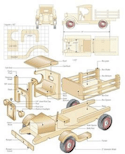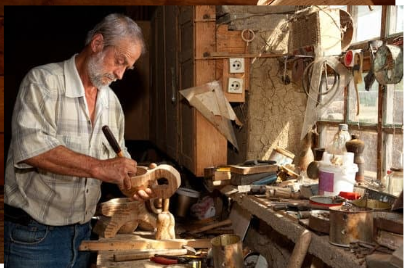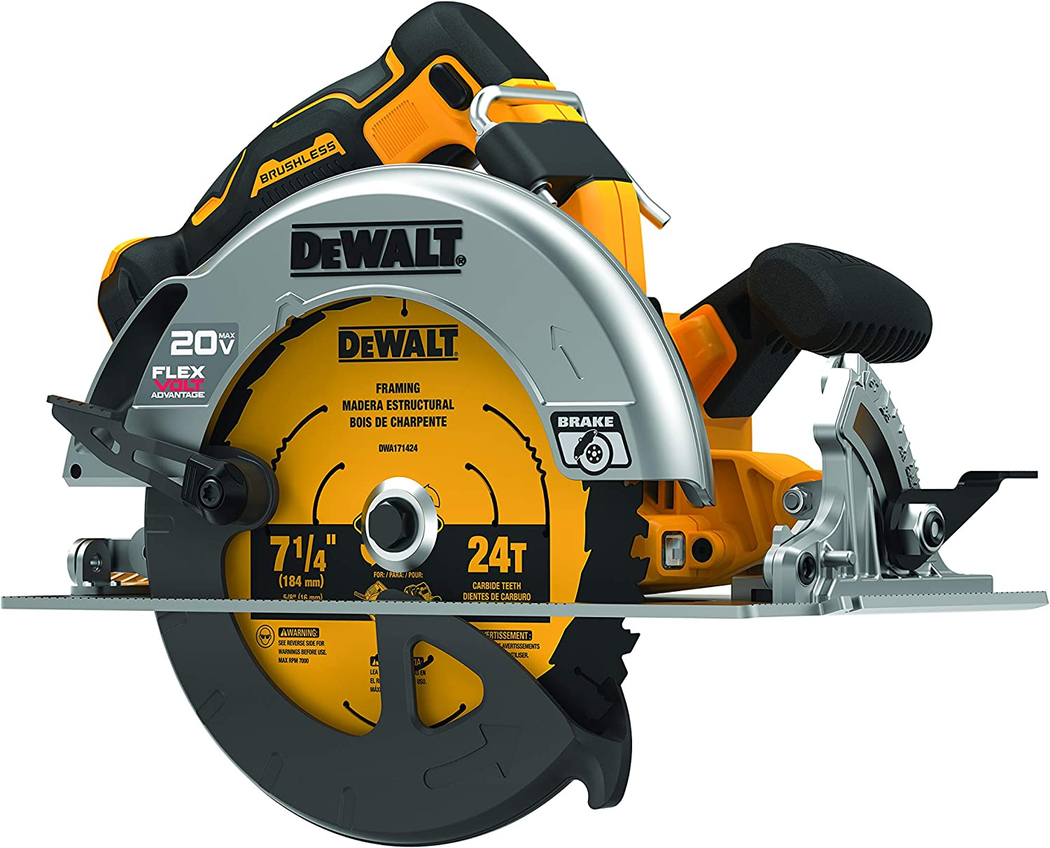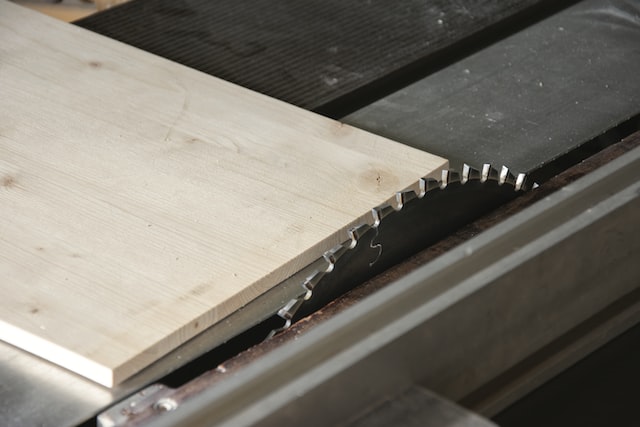Woodworker Tool Chest: 5 Types Of Hand Saws For Woodworking
Get the Right Hand Saws for Your Woodworking Project
Hand saws are cutting tools designed to cut wood. Easy enough. Let’s look at some of the different types of hand saws available in the market and what kind of woodworking they are best suited for. See A Beginner’s Guide to Woodworking for an overview of other essential woodworker tools.
1. Dovetail Saw
A dovetail saw is a fine-toothed handsaw used for woodworking and joinery. It is typically used to cut small, precise, angled cuts known as dovetails. The blade of a dovetail saw is typically thin and stiff, allowing it to make accurate cuts in tight spaces. A dovetail saw can also be used for other applications, such as cutting tenons, rabbets, and splines. In addition to creating dovetails, it can also be used to trim and shape wood into a variety of complex shapes and designs. With the right technique, a dovetail saw is invaluable for any woodworker or joiner.

The recommended dovetail saw should have 19-20 teeth per inch and be sharpened for a ripcut. A pistol-style grip makes pushing the saw easier and controlling the cut.
2. Crosscut Saw
Crosscut saws are used to cut material to length.
- They cut across the grain of the wood, making them ideal for cutting thick sections of wood.
- They have large teeth and relatively thick blades, making them sturdy against rough wood.
- They have a pistol-style handle for a reliable grip.
- Their teeth are filed straight across, while rip saw teeth are shaped like a woodworking chisel.

The recommended crosscut saw has 12-14 teeth per inch and is taller and longer than a dovetail saw. The Spear & Jackson saw in the image is a Western-style carcass backsaw. It is 10 inches long and has 13 teeth per inch.
With its added length and height, this crosscut saw can easily cut parts up to 1 in. thick and 3 in. to 4 in. wide.
3. Dozuki Saw
Dozuki saws are thin and flexible with fine teeth and a straight handle, allowing for accurate and close cutting of pegs. Dozuki saws have no set teeth, so clogging is not an issue. Additionally, dozuki saws are ideal for flush-cutting pegs and should be purchased with around 20 tpi (teeth per inch) sharpened for crosscut. Dozuki saws with their straight handles perform better for flush cutting than Western dovetail saws.

Dozuki saw blades are thin and can kink, so be sure to get a saw that takes replacement blades.
 Unleash your woodworking potential with Ted’s Woodworking – the ultimate collection of 16,000 plans and projects! From step-by-step instructions to detailed schematics, it makes woodworking easy and fun. Join now and enjoy exclusive bonuses. Act fast – this special launch offer ends soon! Advertisement
Unleash your woodworking potential with Ted’s Woodworking – the ultimate collection of 16,000 plans and projects! From step-by-step instructions to detailed schematics, it makes woodworking easy and fun. Join now and enjoy exclusive bonuses. Act fast – this special launch offer ends soon! Advertisement4. Coping Saw
A coping saw is a tool used in woodworking for cutting curved or non-straight objects such as wood, plastic, and metal. It has a blade attached to a frame that’s open at the bottom. The blade protrudes out of the frame and is typically circular with teeth on it. This makes it ideal for cutting curves or doing fine work where a saw’s teeth might get stuck on straight edges.
The main advantage of using a coping saw is that it does not require you to grip the material tightly to guide it along the saw frame. This means you can cut through thin pieces of material without constantly holding them in place with your hands.

Another benefit of using a coping saw is that it offers more precision than other types of saws. This is because its blade allows you to cut precisely where you want it to be cut rather than making random cuts.
You can use a coping saw for many different types of projects, including woodworking projects like making boxes or furniture. It can also be used for repairing broken items or cutting small holes in fabric or paper. The type of blade you choose will depend on the job and materials you’re using. You can choose between blades with teeth or blades without teeth, depending on your preference and the material you’re cutting.
Carpenter Saw (Panel Saw)
The familiar-looking panel saw is the universal go-to saw for cutting long boards, laminates, and PVC to length. You want a rigid blade, comfortable pistol-grip handle, and 8-12 teeth-per-inch with crosscut sharpening.

Frequently Asked Questions About Hand Saws
Why does a different length hand saw feel better in the hand?
Hand saws with pistol grips feel better or more properly put – balanced – when the grip of your hand is perpendicular to a line extended about halfway along the cutting edge of the saw. That’s why a different length of the same hand saw will feel more comfortable in your hand. Here is an illustration from the The Woodworker’s Bible.

How do you choose a good hand saw for wood?
Choosing the right hand saw for woodworking is essential if you want to get the best results. Here’s how you can choose a saw that will make woodworking easier:
1. Identify the type of saw needed for the job: Different types of saws are used for different purposes, such as ripping saws, crosscut saws, coping saws and handsaws etc. so it’s important to know what type of saw is best suited for your project.
2. Consider the size of the saw for the job: You’ll also need to measure and consider the size of the saw based on your project needs. The length and width of the material in your woodworking project will determine what size saw you should use.
3. To cut pieces to length, look for a saw that can cut across the grain of the wood: This ensures that you will be able to make accurate crosscuts with precision and efficiency.
4. Look for a saw that can make curved cuts: If you plan on making intricate designs or patterns in your woodworking projects, look for a saw with teeth designed to make smooth curved cuts.
Can I get by with just a hand saw?
You sure can! Hand saws are highly versatile tools and can be used for various woodworking projects depending on the type of saw. For example, there is a back saw, dovetail saw, tenon saw, crosscut saw, rip-cut saw, and modern bow-cut saws designed for outdoor cutting logs.
Rip-cut saws are designed to cut wood parallel to the grain, with few teeth per inch, each of which is sharp to remove chips of wood. They’re suitable for cutting thicker pieces of lumber and joinery pieces such as dovetails. They’ll also help in creating curved cuts when required.
All in all, no matter what type of hand saw you decide to use, they’ll be suitable for most types of woodworking tasks. As long as you care for your saws and keep them sharpened, they should last you a lifetime.
If you think you’ll need a power saw, check out this article on the best cordless circular saw.
What type/quality of hand saw should I purchase?
When it comes to purchasing a hand saw, it is essential to consider the different types of saws, their blade qualities, and how they should be used. Different types of saws on the market include back saws, dovetail saws, tenon saws, coping saws, and more.
For best results, look for a saw with replaceable blades so you can extend the tool’s longevity even more. You can find great options from eBay, such as vintage crosscut hand saws or newer panel saws from Taylor Toolworks, Woodcraft, and Highland Woodworking.
If you are looking for furniture-making saws, you should consider a Western-style carcass backsaw with 12-14 tpi (teeth per inch). This type of saw typically comes with a blade that is taller and longer than a dovetail saw. Furthermore, using a sawhook when cutting small parts is recommended as it increases accuracy and keeps the saw cutting straight and square.
What is a “go to” hand saw?
A go-to hand saw for woodworking is the Tenon saw. It’s a great saw to start with, as it has a long blade that makes crosscuts and rip cuts easier. Additionally, it’s used for making fine joinery cuts like dovetails or tenons.
Another woodworking saw that you will love using is the Bow Cut saw. This saw is a modern crosscut with curved blades and teeth that allow more precise cuts in hardwood and softwood.
Finally, use the Mortise and Tenon joints to make super strong woodworking joints with hand tools. This saw allows you to create dovetail joints, miters, crosscut tenons, and many other types of joinery cuts.
All these different saws can be sharpened easily with sharpening stones or electric sharpeners to keep them in top condition for woodworking projects!
Are there any drawbacks to using a hand saw for wood?
Yes, there are some drawbacks associated with using a hand saw for woodworking projects. Firstly, when cutting through wood with a hand saw, you may experience blowout resulting from wood splinters and tear-out on the workpiece. This can be avoided by using a sawhook.
Secondly, cutting thick sections of wood with hand saws can be difficult and time-consuming as they require a lot of strength and skill. And if you’re looking to do demolition work, a power saw might be more suitable and help you finish the job quicker.
Furthermore, pruning trees with a hand saw requires both manual strength and precision to be done properly. A power saw may offer better accuracy in these cases.
So, while a hand saw offers certain advantages, such as portability, it is always wise to judge the type of woodworking project you need to do before opting for one tool over another.
Is a Miter Saw Worth It?
A miter saw can definitely be worth it if you are looking for a tool that is versatile and easy to use. A miter saw is great for woodworking beginners because it is best used for cutting down lengths of lumber that are not wide or thick, such as 2x4s, trim pieces, furring strips, and shiplap. Depending on the size and features of the miter saw, users can do different angles, bevel cuts, miter cuts, or dual bevel cuts on lumber up to 4x4s width or 6+ inches wide.
So, if you are a beginner looking for an easy-to-use tool with different cutting capabilities, a miter saw might just be what you need!
Which Hand Saw for wood working do you need to get started?
When getting started with woodworking, there are many types of saws to choose from. Joshua Farnsworth recommends the best saws for woodworking, such as back saws, dovetail saws, tenon saws, and crosscut saws.
Bow cut saws are used for pruning trees and cutting logs, with crosscut teeth that help remove sawdust. Jab saws can be used for working plasterboard, drywall, or plaster while coping saws help create inside miter corners on various types of moldings.
Finally, a chainsaw is a must-have tool if you need to do lot clearing or firewood cutting.
What are the two main types of hand saws?
The two main types of hand saws commonly used in woodworking are panel saws and back saws.
Panel saws have long blades and are mainly used to cut wide, straight lines through large panels of wood. These saws usually produce rough cuts, so smoothing them out is a must before you can consider them finished.
Back saws are smaller saws with finer teeth than panel saws. They’re designed to make precise cuts, such as dovetail joints, miter joints, and crosscuts.
Crosscut saws are another type of handsaw specially designed for cutting wood across the grain. These saw types offer more control over the blade and can help you quickly make cleaner cuts.
Jigsaws are powered saws that make a back-and-forth or up-and-down action, depending on the model. They’re typically used for more intricate cuts like circles and curves, and may even be able to cut metal depending on the blade type you choose.
What are the three types of hand saws?
Three types of hand saws are commonly used in woodworking and carpentry: Panel Saws, Back Saws, and Jigsaws.
Panel saws are larger saws that are used for cutting large pieces of wood to size. They usually have long blades with around 6-8 teeth per inch so that they can make quick work of larger woodworking projects.
Back saws are smaller ones best used for precise and delicate cuts, such as moldings, pulls, and drawer stops. They typically have 10-12 teeth per inch, and a miter box is often used along with it for accuracy.
Crosscut saws (also known as Western-style carcass backsaws) have 12-14 teeth per inch and are better for cutting across the grain of the wood.
Lastly, jigsaws (also known as saber saws) are reciprocating saws with a ½-¾ inch stroke. They have variable speed settings and cutting modes and can be used for more intricate cuts than the other saw types mentioned above.
What is the fastest way to cut big wood with a hand saw?
 For those looking for the fastest way to cut wood with a hand saw, chainsaws are the tool of choice. Two-cycle gas engines or electric motors typically power these power saws and are ideal for cutting down large trees. Chainsaws can also be used to sculpt stunning works of art.
For those looking for the fastest way to cut wood with a hand saw, chainsaws are the tool of choice. Two-cycle gas engines or electric motors typically power these power saws and are ideal for cutting down large trees. Chainsaws can also be used to sculpt stunning works of art.
Another great tool for sawing wood is a bowcut saw. This medium-sized saw is used to prune trees as well as cut logs. It has crosscut teeth that can remove sawdust while cutting, making it suitable for making curved cuts in thick sections of wood.
What are the first 2-3 LN saws I should get?
If you are starting out with lumberworking and saws, there are a few saws that you should consider adding to your toolbox. The first saw is a crosscut saw which is great for making clean, accurate cuts on parts up to 1 inch thick and 3-4 inches wide. Secondly, a Western-style carcass backsaw is perfect for making small parts such as moldings, pulls, drawer stops, and pegs. Lastly, you might want to include a jab saw which comes in handy when dealing with plasterboard, plaster, or drywall. Additionally, consider a coping saw for making inside corners on various moldings and a stainless steel blade bone saw for cutting bones.
Is there a difference between portable and fixed-blade hand saws for wood?
Yes, there is a difference between portable and fixed-blade hand saws for wood.
Portable saws are typically lighter in weight, with shorter blade lengths, making them ideal for pruning trees and cutting logs. On the other hand, fixed-blade saws are more suitable for making precision cuts across the wood grain and can also be used to make curved cuts.
Dual-cut (or “hybrid”) handsaws, which have an average of 6 to 8 TPI (teeth per inch), offer the best of both worlds – they are a combination of portable saws and fixed-blade saws. They are great for making precise cuts in wood but can also be used to cut metal, wood, and plastic.
How do you sharpen a hand saw with a file?
- Start by selecting a file the same size as the teeth of your hand saw.
- Secure the saw blade in a vise and make sure it won’t move while you are filing.
- Place the file against the face of the tooth and push it forward with light pressure.
- Move the file back to its starting position while continuing to apply light pressure.
- Repeat this process for each tooth, making sure to keep an even angle and pressure throughout.
- Once all of the teeth have been filed, use fine grit sandpaper to remove any burrs or rough edges.
How To Sharpen A Handsaw With A File And Accomplish More (wherecanibuythat.us)
References:
Woodworking With Hand Tools – Tools, Techniques & Projects, 2018 Editors of Fine Woodworking
The publisher earns affiliate commissions from Amazon for qualifying purchases. The opinions expressed about the independently selected products mentioned in this content, and any instructions or content shared are those of the publisher, not Amazon.



















3 Comments